In 1783 Rev. John Mitchell put forth the idea of a dark star, one with such gravity that light could not escape it1. But after Thomas Young showed that light acts as a wave, rather than particles, the idea lay dormant for more than a century. In 1916, on the heels of Albert Einstein’s general theory of relativity, Karl Schwarzschild mathematically described space and time around a spherical mass, and calculated the “event horizon”, the radius inside which light could not escape2. In the 1930’s, Subrahmanyan Chandrasekhar calculated the mass (1.4 suns) at which a spent star must crunch into a neutron star, and J.R. Oppenheimer calculated the mass (3.2 suns) at which a spent star must crunch into a dark star3, which in the late 1960’s came to be called a “black hole15“.
In 1972 NASA launched Uhuru, the first satellite x-ray observatory, from off the coast of Kenya. Uhuru tracked x-rays coming from Cygnus X-1, one star of a binary star system4. X-rays shoot from a dense, crunched star as it pulls and heats matter from its companion star. The fast flicker of the x-rays and the wobble in the spectral picture of the companion star showed that Cygnus X-1 has extremely small size and large mass, and made it our first black hole candidate5.
In 1937, in suburban Chicago, Grote Reber used his homemade backyard radio telescope to identify a strong source of radio waves in Cygnus16. In 1951 Walter Baade focused the big Palomar telescope on the radio source in Cygnus A to take spectral pictures. The pictures showed emission lines indicating very high energy and a red-shift indicating very great distance – to another galaxy14. Further radio wave observations showed opposing plumes of particles from Cygnus A several times larger than the galaxy itself. In 1961 Fred Hoyle and William Fowler proposed that such radio galaxies were due to collapse of the mass of ten million to a hundred million suns, and by the late 1960’s the idea of super-massive black holes at galactic cores took hold7. In 1974 scientists at the main National Radio Astronomy Observatory facility, in Green Bank, West Virginia, detected a strong radio source, which they named Sagittarius A* (pronounced “A-star”), at the center of the Milky Way6.
In 1990 NASA sent space shuttle Discovery to launch the Hubble telescope, the first of its four “great observatories”, each detecting a different radiation band – infra-red, visible light, x-rays and gamma rays. In 1994 Hubble, the visible light observatory, found a spiral-shaped disk of hot gas revolving rapidly around the core of the M87 galaxy, just as material would revolve around a super-massive black hole8. In 1999, space shuttle Columbia astronauts launched the Chandra x-ray observatory (named after Chandrasekhar). Chandra soon detected x-rays from the center of the Milky Way, giving further evidence that Sagittarius A* is a super-massive black hole9.
In 2002, the European Southern Observatory announced the result of ten years of observation of stars near the center of the Milky Way. One star, S2, was found to sling around Sagittarius A* in a close, fifteen-year orbit – the tight orbit that a star would have around a super-massive black hole10. In November 2005, using the National Science Foundation’s Very Large Baseline Array of synchronized radio telescopes spread across the continent, scientists showed the closest picture yet of Sagittarius A*x11. Science agencies in Europe and North America are now building a larger and more detailed radio telescope array, the Atacama Large Millimeter Array (ALMA). With ALMA we may see right up to the event horizon, the very “shadow” of the Milky Way’s central black hole12x13.
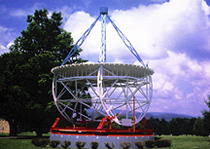
Grote Reber’s homemade backyard radio telescope (Photo: NRAO)
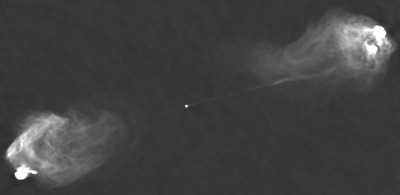
Cygnus A galaxy radio jets & plumes, VLA radio image.
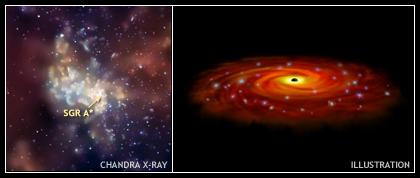
The center of the Milky Way, Chandra x-ray image.
Credit: X-ray: NASA/CXC/MIT/F.K.Baganoff et al.; Illustration: NASA/CXC/M.Weiss
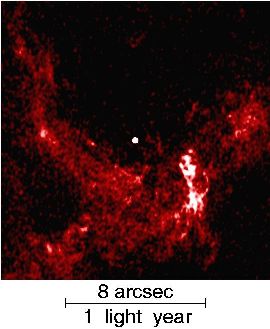
The center of the Milky Way, VLA radio image.
Sagittarius A* is the bright white dot at center.
CREDIT: NRAO/AUI/NSF, Jun-Hui Zhao, W.M. Goss
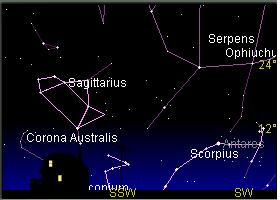
Sagittarius, Cleveland, Sept. 21, 9:00pm edt
Electromagnetic Radiation Spectrum
short waves, high frequency
Gamma Rays
X-Rays
Ultra-violet
Visible
Infra-red
Microwave
Radio
long waves, low frequency
Note: wavelength x frequency = speed of light
Star Life Cycles
| Phase | Description | Medium Mass | HighMass | Highest Mass |
| Burn | Fuses hydrogen to helium to carbon. | main sequence star | main sequence star | main sequence star |
| Puff | Shell expands. | red giant | red supergiant | red supergiant |
| Blast | Fuses to iron and explodes. | – | supernova | supernova |
| Crunch | Core collapses. | white dwarf | neutron star | black hole |
Sources
1 ‘Dark Stars (1783)’ – Thinkquest.org
The concept of black holes was first introduced over two centuries ago. In 1783, Reverend John Mitchell, an amateur British astronomer, proposed that gravity could affect light as well as matter. Mitchell showed that an object with the density of the sun, yet five hundred times larger would exert a gravitational pull so great that “all light emitted from such a body would be made to return toward it.”
In 1795, Pierre-Simon Laplace, a French physicist who independently reached the same conclusions, reasoned that: “it is therefore possible that the greatest luminous bodies in the universe are on this account invisible.”
Both Mitchell and Laplace believed that the escape velocity, the speed necessary to escape the star’s gravity, for a sufficently large star would be greater than the speed of light. Because light could not escape from the gravitational pull, the dark star would appear invisible to an observer against the night sky. Both theories were based on Newton’s theory of gravitation and corpuscular light.
For many years afterward, the idea of an object with enough gravity to keep itself invisible was discarded by many scientists because in 1799 Thomas Young demonstrated that light acted as a wave. It would take another century before the idea of black holes would come back into the light.
2 ‘Schwarzschild’s Solution (1916)’ – Thinkquest.org
The modern concept of the black hole was introduced in 1916. Briefly following the release of Einstein’s General Relativity, Karl Schwarzschild, a German physicist, discovered a mathematical solution to Einstein’s field equations that described the gravitational field of a point mass while fighting for the German army in World War I. Schwarzschild died several months later from a rare disease contracted during the war.
This solution, known as Schwarzschild Geometry, describes the space and time around any spherical mass including the distance from the center of a sphere at which light cannot escape. This distance is known as the Schwarzschild Radius (rs). If the mass of an object is entirely inside the Schwarzschild Radius, we have a perfectly spherical, non-rotating black hole.
3 ‘Limits of Gravity (1930-1939)’ – Thinkquest.org
For some time, black holes would remain only an incarnation of relativity. How could such an object actually exist in nature? The answer lies in the death of a star.
In 1930, Subrahmanyan Chandrasekhar, an Indian physicist, calculated the mass limit (1.4 solar masses) of a star by which its gravitational collapse would be prevented by the exclusion principle for electrons and become a white dwarf. A white dwarf with mass greater than this limit is unable to support itself against its own gravitational pull and crunches into a neutron star.
In 1939, J.R. Oppenheimer, an American scientist, calculated that maximum mass limit of a neutron star is about 3.2 solar masses. Oppenheimer proposed that in a star with mass over this limit, gravity would be unopposed and the star would become a black hole. Oppenheimer would later abandon his work on black holes to help build the atomic bomb during World War 2.
4 ‘Major Milestones In X-ray Astronomy’ by WKT
Date: December 1970 to March 1973
Vehicle/Mission: Uhuru X-ray satellite
Agency/Country: NASA
Instruments/Detectors: Proportional counters (2 -20 keV)
Mirror Description: No mirrors
Highlights: Uhuru, the first satellite dedicated to the observation of cosmic X-ray sources, was equipped with a sensitive proportional counter attached to a viewing pipe to locate the sources. It expanded the number of known sources to more than 400, showed that X-ray stars are neutron stars or black holes accreting matter from companions in binary star systems, and discovered X-rays from hot gas in galaxy clusters.
5 ‘Cygnus X-1 (A Black Hole)’ – Thinkquest.org
In 1972, an invisible X-ray source from the constellation Cygnus was first detected by X-ray observatory Uhuru (Swahili for “freedom”) and named Cygnus X-1. The X-ray source was found to orbit every 5.6 days around its companion HDE 226868, a blue supergiant with 30 solar masses.
Why was Cygnus X-1 considered a black hole? For starters, Cygnus X-1 flickers at less than a thousandth of a second bursts. For an object to flicker, light must travel all the way across its surface. So if light travels 300 kilometers per thousandth of a second, that must mean that Cygnus X-1 is much smaller than our planet.
Second, HDE 226868’s spectral lines wobble because of the gravitational pull of Cygnus X-1. In order for that to be possible, scientists estimate that Cygnus X-1 must have at least 7 or more solar masses, putting its mass way beyond the Oppenheimer-Volkoff Limit for a neutron star.
6 Radio Astronomers Lift ‘Fog’ On Milky Way’s Dark Heart; Black Hole Fits Inside Earth’s Orbit – Science Daily, April 2, 2004
Sagittarius A* was discovered in February of 1974 by Bruce Balick, now at the University of Washington, and Robert Brown, now director of the National Astronomy and Ionospheric Center at Cornell University. It has been shown conclusively to be the center of the Milky Way, around which the rest of the Galaxy rotates.
…
In March 2004, 55 astronomers gathered at the National Radio Astronomy Observatory facility in Green Bank, West Virginia, for a scientific conference celebrating the discovery of Sagittarius A* at Green Bank 30 years ago. At this conference, the scientists unveiled a commemorative plaque on one of the discovery telescopes.
7 ‘ Giants in the galaxy cores’ – Southampton General Relativity Explorer
An outstanding example is M87, a strong radio source that has been identified with an elliptical galaxy about 50 million light years away. Matter is ejected at relativistic speed from the centre of this galaxy in two gigantic jets that extend for 2600 light years from the core. The energy radiated through the jets is equivalent to that released in something like 10 million supernova explosions! What central engine could lead to the release of such awesome power? The explanation that caught on was the idea that the AGNs are the manifestation of gigantic black holes located at the heart of distant galaxies. In a paper that appeared in Nature on March 16 1961, Hoyle and Fowler suggested that the radiated energy ought to signal the collapse of some kind of superstar.
Our present opinion is that only through the contraction of a mass of 10-100 million solar-masses to the relativity limit can the energies of the strongest sources be obtained. (Hoyle and Fowler 1961)
This was an intriguing proposal, but it was difficult to see how collapse could be the explanation for the observed jets. The gravitational collapse of even such an enormous congregation of matter would only last a day or so, but the jets were evidence of ongoing emission for more than a million years! Whatever the central object was, it must be able to radiate continually for a very long time. Realizing this, Ya B Zeldovich and Igor Novikov envisaged a model based on a some kind of supermassive compact object powered by accretion. They argued that the mass of such an object must be of the order of 100 million solar masses if the luminosity is to be smaller that the Eddington limit (at which radiation pressure balances the pull of gravitation and thus prevents further accretion). Within this model even the strongest observed sources could be fuelled by accretion of just a few solar masses worth of material per year. The idea seemed plausible and a few years later (in 1969) Donald Lynden-Bell suggested that the central object in an active galaxy is a supermassive black hole feeding off of an accretion disk.
8 ‘Hubble Confirms Existence of Massive Black Hole at Heart of Active Galaxy’ – Hubblesite.org
Astronomers using the Hubble telescope have found seemingly conclusive evidence for a massive black hole in the center of the giant elliptical galaxy M87, located 50 million light-years from Earth in the constellation Virgo. Earlier observations suggested that the black hole was present, but they were not decisive.
This observation provides very strong support for the existence of gravitationally collapsed objects, which were predicted 80 years ago by Albert Einstein’s general theory of relativity. This image shows a spiral-shaped disk of hot gas in the core of M87. Hubble measurements indicate that the disk’s rapid rotation is strong evidence that it contains a massive black hole. A black hole is so massive and compact that nothing can escape its gravitational pull, not even light.
9 ‘A Monster in the Middle’ – NASA
If Sag A* really does harbor a black hole, it ought to shine as an X-ray source. The X-rays would come from hot gas in an accretion disk swirling into the dense gravitational field of the hole. Previous X-ray satellites lacked the combined resolution and sensitivity to make this basic test. But now, thanks to the Chandra X-ray Observatory, astronomers finally have the data they’ve been waiting for.
A group of researchers led by Frederick K. Baganoff and colleagues from Pennsylvania State University announced last month that a faint X-ray source, newly detected by Chandra, may be the long-sought X-ray emission from a supermassive black hole at the center of the Milky Way.
“The race to be the first to detect X-rays from Sagittarius A* is one of the hottest and longest running in all of X-ray astronomy,” Baganoff said. “Theorists are eager to hear the results of our observation so they can test their ideas.”
Chandra’s remarkable detection of this X-ray source has placed astronomers within a couple of years of a coveted prize: measuring the spectrum of energy produced by Sagittarius A* to determine in detail how the supermassive black hole that powers it works.
As the high energy X rays stream away from the vicinity of the black hole, they heat the blanketing gas to temperatures of a few million degrees, and the blanket absorbs some of the X rays from the central source. This produces dark stripes, or absorption lines in the X-ray spectrum. Bright stripes or emission lines due to emission from the blanketing gas are also present. Since each element has its own unique structure, these lines can be read like a cosmic bar code to take inventory of the gas. The team was able to determine what atoms the gas contains and how many, the number of electrons each atom has retained in the hostile environment of the black hole, and how the gas is moving there. They found lines from eight different elements including carbon, nitrogen, oxygen, and iron. The amount of this gas was found to be about 100 times greater than that found with optical and ultraviolet observations.
10 ‘Star Orbiting Massive Milky Way Centre Approaches to within 17 Light-Hours’ – European Southern Observatory
No event like this one has ever been recorded . These unique data show unambiguously that S2 is moving along an elliptical orbit with SgrA* at one focus, i.e. S2 orbits SgrA* like the Earth orbits the Sun, cf. the right panel of PR Photo 23c/02 .
The superb data also allow a precise determination of the orbital parameters (shape, size, etc.). It turns out that S2 reached its closest distance to SgrA* in the spring of 2002, at which moment it was only 17 light-hours <5> away from the radio source, or just 3 times the Sun-Pluto distance. It was then moving at more than 5000 km/s, or nearly two hundred times the speed of the Earth in its orbit around the Sun. The orbital period is 15.2 years. The orbit is rather elongated – the eccentricity is 0.87 – indicating that S2 is about 10 light-days away from the central mass at the most distant orbital point <7>.
11 ‘Astronomers Get Closest Look Yet At Milky Way’s Mysterious Core’ – National Radio Astronomy Observatory
The astronomers used the VLBA to measure the size of an object called Sagittarius A* (pronounced “A-star”) that marks the exact center of our Galaxy. Last year, a different team announced that their measurements showed the object would fit inside the complete circle of Earth’s orbit around the Sun. Shen and his team, by observing at a higher radio frequency, measured Sagittarius A* as half that size.
A mass equal to four million Suns is known to lie within Sagittarius A*, and the new measurement makes the case for a black hole even more compelling than it was previously. Scientists simply don’t know of any long-lasting object other than a black hole that could contain this much mass in such a small area. However, they would like to see even stronger proof of a black hole.
…
In a few years, when the Atacama Large Millimeter Array (ALMA) comes on line, it may be used in conjunction with other millimeter-wave telescopes to make the higher-frequency observations that will reveal the telltale black-hole shadow.
The Atacama Large Millimeter Array (ALMA) is an international astronomy facility. ALMA is an equal partnership between Europe and North America, in cooperation with the Republic of Chile, and is funded in North America by the U.S. National Science Foundation (NSF) in cooperation with the National Research Council of Canada (NRC), and in Europe by the European Southern Observatory (ESO) and Spain. ALMA construction and operations are led on behalf of North America by the National Radio Astronomy Observatory (NRAO), which is managed by Associated Universities, Inc. (AUI), and on behalf of Europe by ESO.
13 ‘A Quest to See a Black Hole’s Shadow’ – Space.com
Astronomers have already detected radiation from hot spots just outside the black hole, and they believe that these will paint a background against which the black hole’s profile, or shadow, will stand out.
14 ‘Cygnus A, Quasars, and Quandaries’ – The Chandra Chronicles, March 13, 2001
When Walter Baade and Rudolph Minkowski obtained the spectrum of Cygnus A, they found what they considered to be proof of colliding galaxies: emission lines that indicated they were produced by gas in a high state of excitation.
…
The spectrum also showed that the emission lines were all red-shifted by the same amount. This in itself was not unexpected, since two decades earlier Edwin Hubble and his colleagues had shown that the spectra of distant galaxies would show a red-shift proportional to their distance. The difficulty was that the measured red-shift implied that Cygnus A was very distant — possibly 1 billion light years distant!
…
It has the shape of a great cosmic dumbbell, with two huge lobes of high-energy particles located over half a million light years apart. The galaxy, which is several times smaller than the lobes, is located in the middle. It was beginning to look as if the radiation from Cygnus A was not due to galaxies in collision, but to some mysterious explosive process where high-energy particles were being blown out of the galaxy!
15 ‘Black Holes and Time Machines’ By Sir Martin Rees, Astronomer Royal
The term ‘black hole’ itself was not coined until 1968, when John Wheeler described how an infalling object ‘becomes dimmer millisecond by millisecond…light and particles incident from outside …go down the black hole only to add to its mass and increase its gravitational attraction.’
16 ‘The Discovery of Cygnus A’ – The Chandra Chronicles, January 31, 2001
In 1946, many engineers and scientists in the United Kingdom and Australia used the talents and technology acquired during World War II to explore the sky with radio telescopes. They were especially interested in a region in the constellation Cygnus which had been identified as a strong source of radio waves by radio astronomy pioneer Grote Reber, who had used a $2,000 homemade radio telescope in his back yard in Wheaton, Illinois to make a radio map of the Milky Way.
…
Francis Graham Smith used an improved radio telescope in Cambridge, England to get a much more accurate position of Cygnus A. Smith airmailed his results at once to Walter Baade at the California Institute of Technology in Pasadena. Within a few weeks, Baade was in the observing cage of the 200 inch telescope on Palomar Mountain. He focused the powerful telescope on the position given by Smith, and took two photographs, one in blue and one in yellow light. The next afternoon, he developed the photographs.
“I knew something was unusual the moment I examined the negatives,” Baade recalled. “There were galaxies all over the plate, more than two hundred of them, and the brightest was at the center. It showed signs of tidal distortion, gravitational pull between the two nuclei — I had never seen anything like it before.
* * *
By Quinn Hungeski – Posted at G.N.N. & TheParagraph.com

Breaking News (week-old should qualify as “breaking” on the astronomical timeline):
“Astronomers Report Unprecedented Double Helix Nebula Near Center of the Milky Way”:http://www.newsroom.ucla.edu/page.asp?RelNum=6903
!http://www.newsroom.ucla.edu/NewsReleaseImages/6903_images/nr_6903a.jpg!